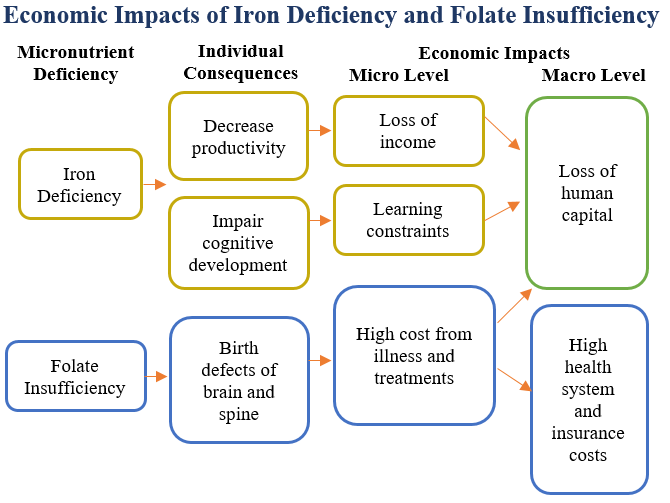Rising temperature and carbon emissions decrease food's nutrient quality
The United Nations (UN) refers to climate change as the “defining issue of our time.” In its most recent report, the UN Intergovernmental Panel on Climate change found that from 1880 to 2012, the average global temperature increased by 0.85 °C. This rise in temperature is directly linked to the rise in greenhouse gasses (GHGs). Carbon dioxide is the most abundant greenhouse gas, accounting for about two-thirds of GHG emissions.
That is relevant for nutrition because increased carbon emissions lowers the nutritional quality of crops. Rising carbon dioxide levels will cause crops to become less nutritious by cutting plants’ nitrogen concentrations, leading millions of people worldwide to face mineral deficiencies. As carbon dioxide levels tick up, plants will become more productive in photosynthesis—which gives plants energy by turning carbon dioxide into oxygen—and less reliant on minerals in the soil, leading them to absorb less nitrogen, phosphorus, and iron from the ground. Staple crops like rice and wheat will be most affected by these nutritional deficiencies, reducing their nutritional quality and negatively impacting global food security.
Additionally, climate change threatens global food production, food systems, and overall nutritional quality of foods. Because of this, climate change is likely to make millions more people nutrient deficient globally.
Fortifying foods, including staple grains, helps prevent nutritional deficiencies. In Costa Rica, anemia declined in women and children, and iron status in children improved after fortification. Also, each year of flour fortification is associated with a 2.4% decrease in anemia prevalence among non-pregnant women. Additionally, when adopted at a national level, fortification helps all individuals, including the poorest of the urban poor, get more of the nutrients they need. This is especially useful when considering how many more people will be living in areas with heightened risks for developing a nutritional deficiency due to climate change.
In general, large-scale food fortification does not place an excess burden on the environment as it uses existing food processing and delivery systems.
Extent of Problem
Climate change could contribute to 175 million more people developing a zinc deficiency by 2050. Additionally, due to climate change, 1.4 billion women of reproductive age and children under five years old will be living in regions where they are at the highest risk of developing iron deficiency. Zinc is important in helping children develop, strengthening immunes systems, and lessening the complications of diarrhea. Iron is important in preventing nutritional anemia. Deficiencies in either of these minerals negatively impact human health. Furthermore, anemia results in lethargy and decreased productivity, and childhood anemia is associated with a 2.5% drop in wages in adulthood.
The amount of carbon in the atmosphere is expected to rise to 550 parts per million (ppm) over the next 40-60 years, and nutritional quality of foods will continue to decline. Fortifying wheat flour, maize flour, and rice with essential nutrients could offset the nutrients lost due to rising carbon emissions.

Healthy people foster economic growth
A country’s economic benefits as a result of improved nutrition are tremendous. Each dollar spent on reducing chronic undernutrition has a $30 payoff, according to the 2012 Copenhagen Consensus.
In a review of the World Bank report An Investment Framework for Nutrition, consultant Julia Dayton Eberwein wrote that “Every dollar invested in [nutrition] interventions would yield between $4 and $35 in economic returns, making investing in early nutrition one of the best value-for-money development actions.”
The nutrients most commonly used in grain fortification are iron and folic acid. The economic benefits associated with these are below.
Iron
Fortification yields $84 for every dollar spent on reducing iron deficiency anemia prevalence [1].
The mental capacity that is undeveloped when children are iron deficient is never regained. That affects their academic performance and future earnings potential. Consequently childhood anemia is associated with a 2.5% drop in wages in adulthood [2].
The median value of annual physical productivity losses due to iron deficiency is $2.32 per capita, based on illustrative calculations for 10 developing countries [2]. Median total losses which include both physical and cognitive losses are $3.64 per capita [2].
These estimates of economic loss from iron deficiency do not include the social costs of maternal deaths due to iron deficiency or healthcare costs of treating infants born prematurely because their mothers were iron deficient.
Folic Acid
Healthcare expenditures are averted when brain and spine birth defects are prevented by fortifying with folic acid. The most common of these birth defects is spina bifida. These children have varying levels of paralysis and loss of bowel and bladder control. They undergo a lifetime of surgeries and treatments which take a toll both emotionally and financially.
Total lifetime cost for patients with spina bifida in 2002 was US $620,484, according to one literature review. That included medical care, development services and indirect costs.
The following countries have compared the cost of fortifying with folic acid and the healthcare savings from preventing brain and spine birth defects:
- Chile calculated one year of costs of surgical treatment and rehabilitative services for people with spina bifida who were less than 22 years old. The results represent a net savings of 2.3 million international dollars[3].
- South Africa estimated the costs of treating infants with spina bifida and reported a net savings of 40.6 million rand[4].
- The United States included the lifetime costs to care for people with spina bifida plus the value of the time required for others to care for the children. The annual net savings is 603 million US dollars[5].
A systematic review showed that mandatory folic acid fortification is cost-effective for neural tube defect prevention at a median cost:benefit ratio of 17.5:1 (0.98:1 to 417.1:1), meaning that for each monetary unit spent in the program, there would be a return of 17.5 monetary units.

Modeling Tool
A tool to help estimate the benefit:cost ratio for your country is available. A locked version has been filled with data from an imaginary country called “Fortifitopia” to illustrate how the spreadsheet works. An unlocked version can be adapted on a country-by-country basis. First download these indicators then follow these directions. For more information, please contact info@ffinetwork.org
(1) Hunt, J., Reversing Productivity Losses from Iron Deficiency: The Economic Case. The Journal of Nutrition. 2002. vol. 132 no. 4 794S-801S.
(2) Horton, S., and Ross, J, The Economics of Iron Deficiency. Food Policy. 2003, 28: 51-75. Also see the corrigendum.
(3) Llanos, A., et. al., Cost-effectiveness of a Folic Acid Fortification Program in Chile. Health Policy. 2007, 83:295-303.
(4) Sayed, A., et.al., Decline in the Prevalence of Neural Tube Defects Following Folic Acid Fortification and Its Cost-Benefit in South Africa. Birth Defects Research. 2008, 82:211-216.
(5) Grosse, Scott, et. al., Retrospective Assessment of Cost Savings From Prevention. American Journal of Preventive Medicine. 2016.
Rodrigues Viviane Bellini, et al., Prevented cases of neural tube defects and cost savings after folic acid fortification of flour in Brazil. PLOS One. 2023.

Address Sustainable Development Goals
The United Nations adopted 17 Sustainable Development Goals (SDGs) in September 2015 with 169 targets. Meeting these targets by 2030 as hoped will require multiple strategies. In many countries fortifying commonly consumed grain products would be a practical step toward meeting the SDGs.
Reducing vitamin and mineral deficiencies is an important tool in achieving the Sustainable Development Goals. Fortification is a relatively inexpensive strategy, benefiting everyone who eats fortified rice or food made with fortified flour, plus it does not require consumers to change behaviors.
Eight of the SDGs can be addressed by fortifying flour and rice. The nutrients most often added are iron, zinc, and the B vitamins folic acid, niacin, riboflavin, thiamin, vitamin B12 and vitamin B6. The partnership called for in SDG 17 is also a critical component of successful fortification programs.

SDG 1. No Poverty
Physical work capacity is hampered when people are anemic. Anemia is estimated to contribute to 17% lower productivity in heavy manual labor and 5% lower productivity in other manual labor. A modeling exercise in India estimated that a birth cohort of individuals with iron-deficiency anemia (IDA) in 2013 will lose more than US$ 24 million over their lifetimes as a result of productivity loss due to IDA.
Additionally, the mental capacity that is undeveloped when children are iron deficient affects their academic performance and future earnings potential. Consequently, childhood anemia is associated with a 2.5% drop in wages in adulthood, affecting both productivity and economic growth.
Nutrient deficiencies that can contribute to anemia include iron, riboflavin, folic acid, zinc, vitamin B12, and vitamin A. Currently, more than 80 countries have legislation to add one or more of these nutrients to wheat flour, maize flour, and/or rice. Adding these nutrients to commonly consumed grains is one step toward improving productivity and thereby reducing poverty.
SDG 2. Zero Hunger
The target of SDG 2.2 is to end all forms of malnutrition. Of all deaths of children under 5 years, 45% are attributed to malnutrition. This goal specifically mentions stunting. Vitamin and mineral deficiencies increase the risk of stunting which affects about 2 billion people.
Additionally, adequate nutrient intake increases productivity in adults, leading to improved productivity in agricultural labor. This will increase agricultural production, subsequently providing growth in the food supply and helping to combat hunger.
Fortification is one of the most effective nutrition interventions in preventing nutritional deficiencies, thus working to reach SDG 2.2.
SDG 3. Good Health and Well-being
This goal focuses on maternal and newborn health, infectious disease, and non-communicable diseases. Fortification helps to reach goals in each of these categories.
Maternal and Newborn Health
A huge advantage of fortifying with folic acid is the reduced risk of birth defects of the brain and spine. One meta-analysis showed that fortifying wheat flour with folic acid reduced the incidence of these birth defects by an average of 46%.
Anemia during pregnancy increases the risk of maternal and perinatal mortality. Anemia during pregnancy also contributes to low birth-weight infants, which the World Health Organization (WHO) defines as weighing less than less than 2500 grams or 5.5 pounds. Newborns that are born small are prone to death and diseases while they are young. If they survive, they are at an increased risk for poor mental development in childhood and chronic health problems such as diabetes and heart disease later in life.
Infectious Disease
Zinc is a mineral that promotes immunity, resistance to infection, and proper growth and development of the nervous system, and is integral to healthy pregnancy outcomes. Zinc deficiencies increase risk of malaria, pneumonia, and diarrhea.
In a 2012 paper, researchers concluded that 17% of the global population is at risk of inadequate zinc intake. While people only need small amounts of zinc, WHO estimates that “worldwide, zinc deficiency is responsible for approximately 16% of lower respiratory tract infections, 18% of malaria and 10% of diarrheal disease.”
Both Cameroon and Fiji have reported improvements in the population’s zinc status after grain fortification began.
Non-Communicable Diseases
Anemia is a non-communicable disease. As noted above, nutritional anemia is caused by vitamin and mineral deficiencies, and adding iron, riboflavin, folic acid, zinc, and vitamin B12 to food during the milling process helps reduce the risk of nutritional anemia.
Another non-communicable disease is diarrhea. A study published in in June 2017 noted that diarrhea remains a leading cause of death globally. The study estimated that 1.31 million people died from diarrhea in 2015, including 499,000 children under age 5 years. While unsafe water and unsafe sanitation remain the leading risk factors, vitamin A and zinc deficiencies also contribute to diarrhea.
SDG 4. Quality Education
Poor health in childhood can lead to reductions in educational achievement. While iron deficiency limits cognitive development, children who have adequate iron have more energy to participate in classroom exercises, and they are more mentally prepared to master the material.
A large body of literature documents the positive impact of iron interventions on tests of cognitive and motor development. This review found, “the available evidence satisfies all of the conditions needed to conclude that iron deficiency causes cognitive deficits and developmental delays and that these can be at least partially reversed by iron therapy, though the effect may diminish among older children.”
SDG 5. Gender Equality
Anemia rates in females are much higher than males. While anemia rates decrease for males by the end of puberty, they remain high for females through reproductive years due to menstruation.
Therefore, reducing anemia by fortifying with iron contributes to boosting females’ relative academic performance and worker productivity and helps achieve gender equality.
SDG 8. Decent Work and Economic Growth
In a review of the World Bank report An Investment Framework for Nutrition, consultant Julia Dayton Eberwein noted that investing US$ 10 per child per year above current spending for nutrition-specific interventions would have enormous impacts. She wrote that “Every dollar invested in this package of interventions would yield between US$ 4 and US$ 35 in economic returns, making investing in early nutrition one of the best value-for-money development actions.”
According to the 2015 Global Nutrition Report, the returns on investing in improved nutrition outperforms returns generated by the US stock market over the past 70 years. As of 2017, the cost of undernutrition is at least 8-11% of the gross national product. Reducing this cost could help bring communities out of poverty.
Healthcare expenditures are averted when folic acid (vitamin B9) is included in fortification to prevent birth defects of the brain and spine. Spina bifida is the one of the most common of these birth defects; it cannot be cured, and it often leads to some level of paralysis and bowel and bladder control problems. Total lifetime costs for medical care, development services and indirect costs for patients with spina bifida in 2002 was US$ 620,484, according to one literature review.
In addition, adults who care for children with spina bifida spend time making medical appointments, taking children for treatment, and helping children with many daily activities such as toileting and mobility. Adults with spina bifida are very often independent and productive, but they usually require ongoing and often intensive medical care. Moreover, a study of 88 people in Germany with spina bifida found that physiotherapy was the most used healthcare resource, and more than half the study participants used a wheelchair. The authors concluded that their care givers “might have to either adjust their careers overall or adjust their working schedule, resulting in productivity losses”.
All of these examples show how grain fortification could be an effective at promoting decent work and economic growth, working to reach this SDG.
SDG 10. Reduced Inequalities
Low- and middle-income countries bear most of the burden in nutrient deficiencies. This increases the risk of death, morbidity, and susceptibility to negative health outcomes that could be mitigated. The 2015 Global Nutrition Report presents stunting rates by wealth quintile, showing how current inequality predicts future inequality.
Each dollar spent on reducing chronic undernutrition has a thirty-fold payoff, according to the 2012 Copenhagen Consensus. The 2008 Copenhagen Consensus ranked fortification as the third greatest opportunity to fight development challenges, highlighting the opportunities for iron fortification.
SDGs aim to combat inequalities within and among countries. Thus, it is important to note that vitamin and mineral deficiencies can be problems in high-income countries as well as low- and middle-income countries. In the US, for example, fortification of salt with iodine began in the 1920s, fortification of milk with vitamin D began in the 1930s, and the fortification of wheat and maize flour with thiamine and niacin began in the 1940s. These efforts are greatly responsible for the eradication of diseases such as goiter, rickets, beriberi and pellagra, respectively, in the United States. In addition, 767 incidents of spina bifida were prevented in one year after the US added folic acid to its fortification standard. Fortifying with folic acid can decrease birth defects overall regardless of economic status of a country.
SDG 11. Sustainable Cities
More people now live in cities than rural areas, and 30% of urban dwellers live in slum conditions. Urban residents are likely to benefit from fortification of industrially milled flour and rice. Consequently, grain fortification is an opportunity to improve the nutrient intake of a significant proportion of the population, including the urban poor who shop in informal markets.
SDG 17. Partnerships for the Goals
While adding essential nutrients to food addresses the above SDGs, maintaining a successful fortification program requires the partnerships called for in this goal. Effective partnerships are essential for food fortification because no sector can be successful on its own.
This study of fortification in Chile, Costa Rica, and Guatemala found that cooperation from different sectors is key as each is responsible for a different aspect of the process. Researchers found that a variety of players were responsible in creating effective fortification programs, including the following:
An influential individual to support fortification
An institution with research capacity to monitor impact
Food industry to fortify food
Policy makers who ensure fortification was mandatory nationwide
Other agencies to monitor and ensure compliance was enforced
Creating and maintaining effective partnerships is a high-maintenance activity. The first recommendation to any country considering fortification is to form a national alliance. Seek participation and commitment from national leaders representing public, private, and civic sectors. Be sure each stakeholder understands the health and economic benefits for fortification. Involving all sectors early in the process prevents overlooking key information. It also builds commitment from each group to work toward success.
The Food Fortification Initiative brings partners together with the goal of reducing vitamin and mineral deficiencies through food fortification. In doing so, the partners are also taking steps to address nine of the 17 SDGs.





